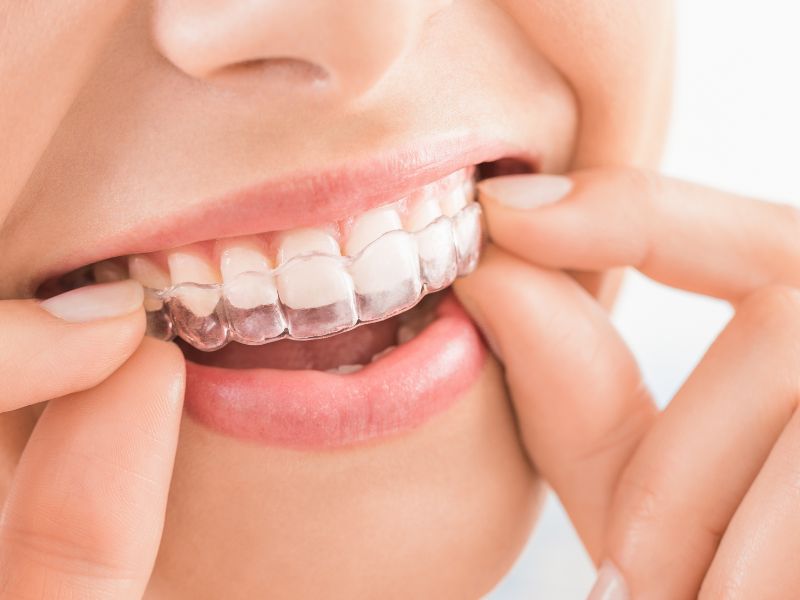
In today’s world, having straighter teeth isn’t just about aesthetics – it can also improve your oral health and boost your confidence. When it comes to achieving a perfectly aligned smile, two of the most popular options are Invisalign and traditional braces. Both methods are highly effective, but they differ in terms of appearance, treatment process, and lifestyle impact. Here, we’ll help you understand the key differences to make an informed choice that best suits your needs.
Understanding Invisalign
Invisalign uses a series of clear, custom-made aligners to gradually shift teeth into their desired positions. Each set of aligners is worn for about two weeks before moving on to the next one in the series. Invisalign aligners are nearly invisible and can be removed for eating, drinking, and brushing.
Advantages of Invisalign
- Aesthetic Appeal: Clear aligners are almost invisible, making them an ideal choice for those who want a discreet teeth-straightening option.
- Comfort: Since Invisalign aligners are made from smooth plastic, they tend to be more comfortable and gentler on the mouth than metal brackets.
- Flexibility: Aligners can be removed, allowing for easy eating, drinking, and dental hygiene. This makes it easier to brush and floss thoroughly, reducing the risk of plaque build-up.
- Fewer Office Visits: Invisalign patients often require fewer visits to the dental office since there are no wires or brackets that need adjusting.
Considerations for Invisalign
- Discipline: Invisalign aligners must be worn for at least 20-22 hours a day to achieve the desired results. Patients who frequently remove their aligners may experience longer treatment times.
- Limited Scope: While Invisalign can treat most alignment issues, complex cases may require traditional braces or other orthodontic treatments for optimal results.
How Traditional Braces Work
Traditional braces use metal brackets and wires to move teeth into alignment. Brackets are bonded to each tooth and connected by a wire, which is periodically adjusted by an orthodontist to guide the teeth into position.
Advantages of Traditional Braces
- Effectiveness: Braces are highly effective for treating a wide range of orthodontic issues, from minor misalignments to more complex cases.
- No Discipline Required: Since braces are fixed to the teeth, there’s no risk of forgetting to wear them, making them ideal for patients who may lack the discipline for removable aligners.
- Variety of Options: Today’s braces come in various styles, including ceramic braces that blend with the natural color of teeth, making them less noticeable than traditional metal options.
Considerations for Traditional Braces
- Appearance: Metal brackets are more noticeable, which may be a concern for some patients, particularly adults.
- Oral Hygiene Challenges: Braces can make brushing and flossing more difficult, requiring patients to be diligent to prevent plaque build-up around the brackets.
- Diet Restrictions: Patients with braces need to avoid hard, sticky, or chewy foods that can damage the brackets or wires, making meal times less flexible.
Invisalign vs. Traditional Braces: How to Choose
When deciding between clear aligners like Invisalign and traditional braces, consider the following factors:
- Aesthetics: If appearance is a primary concern, Invisalign is a discreet option that provides effective teeth straightening with nearly invisible aligners. For those who don’t mind the look of braces or want a more customized look, modern braces offer options like ceramic brackets.
- Complexity of Treatment: Traditional braces are generally more versatile and can handle severe alignment issues, whereas Invisalign is typically best for moderate adjustments. During a consultation, your dentist or orthodontist can assess your specific needs and recommend the most effective option.
- Lifestyle and Commitment: Invisalign provides the flexibility to remove aligners, which can be a significant advantage for people with busy or social lifestyles. However, removable aligners require discipline; if you’re concerned about compliance, traditional braces might be a better choice.
- Maintenance and Oral Hygiene: Invisalign aligners make brushing and flossing easy since they’re removable, which can be advantageous for patients concerned with long-term dental hygiene. Braces, on the other hand, require more meticulous cleaning but offer consistent results without the need for daily discipline.
Which Option is Best for You?
The choice between Invisalign and traditional braces ultimately depends on your unique dental needs, lifestyle, and personal preferences. Invisalign may be the ideal solution if you’re seeking a low-profile treatment with flexibility. However, for complex orthodontic needs or if you’re less inclined to maintain aligner wear, traditional braces can offer more predictability and control.
By consulting with a cosmetic dentistry specialist, you can determine the most suitable path to achieve a healthier, straighter smile. North Shore Smile offers both Invisalign and traditional braces, allowing patients to explore the options and select the treatment that aligns with their goals. We’re here to help you make an informed decision so you can enjoy a lifetime of confident, beautiful smiles.
Ready to get started on your teeth straightening journey? Contact North Shore Smile today to schedule a consultation and explore the benefits of Invisalign and traditional braces. We’ll help you find the best path to your perfect smile!
